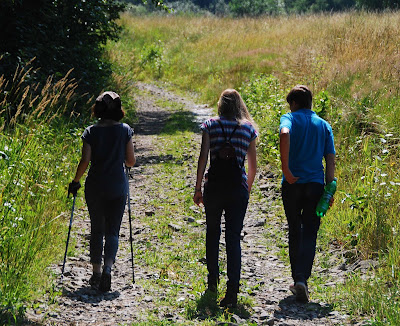What a day. Raining since daybreak, temperature averaging a little over 12C. A good time to do some cleaning. Something I've wanted to do for a while now is to make some room on my bookcases and put my display of model aircraft into the attic.
Model aircraft? Yes indeed, dear reader. Soon after moving to our (then) new house on ul. Trombity in 2002, I was infected by a desire to re-visit an important part of my childhood, namely the sticking together and painting of model aircraft (see
this post on my blog about my formative years).
In keeping with my good Polish patriotic sentiments, I began a small project which grew and grew - to make, in 1/72 scale, replicas of all the various aircraft which Polish squadrons serving with the Royal Air Force flew during WWII. For the best part of five years, this became my chief hobby. I bought scores of books in Polish and English, scores of plastic models, paints, decals (transfers) with Polish squadron markings.
300, 301, 302,
303, 304, 305, 306, 307, 308, 309, 315, 316, 317, 318, 663, 'Skalski's Circus' - the
Polish Fighting Team, as well as various training units. I've built Spitfires, Hurricanes, Mustangs, Defiants (fighters), a Lancaster and Wellington (bombers); Mosquito and Beaufighter (fighter-bombers); Tiger Moth, Dragon Rapide, Harvard, Magister (trainers).
And so, having built and painted 30 or so models, I displayed them in my bedroom, where they've been doing nothing else except gathering dust.
In February 2007 I bought my Nikon D80, and in doing so I returned in a big way to the principle hobby that occupied much of my free time from student days to fatherhood - photography. But digital photography offers so many more possibilities than the traditional type! Within weeks of buying the camera, I started this blog. The initial idea was to use this new media to showcase my photographs from our neighbourhood. And in the wake of photography - writing.
Once the blogging bug had bit me, the plastic aeroplanes ceased to be of interest. They stood there, gathering more dust (removing the dust meant risking damage to fragile parts - tiny radio aerials or gun barrels), I felt sentimentally attached to my handiwork... But there comes a time when we must move on. The period 2002- early 2007 was a resurgence of childhood, the smell of glue and the paint, the delicate fingerwork to get tiny pieces precisely right... Was it worth it?
Honestly? No. As a pastime, it was that. It passed the time. A craft skill, but one that was ultimately not creative. I was not doing anything new, anything that had never been done before. Photography is an outlet for one's vision, sharing what one sees and feels. And writing. Putting one's thoughts on a blog, where they can be read by thousands of people each month, is far more satisfying, and ultimately more useful, than sticking together plastic scale replicas of WWII aircraft.
And so what's happened to them? They have been carefully stored, amid balls of lightly-scrunched up newspaper, in crates, and taken up to the attic. Ideally, they'd be worthy of a museum (any suggestions?). I'm leaving just a few models on display, representing the most famous of all the Polish squadrons, 303, from the Battle of Britain through to the unit's decommissioning in 1946.
 Hawker Hurricane Mk I, V6665 RF-J , 303 (Polish) Sqn, Northolt, September 1940.
Hawker Hurricane Mk I, V6665 RF-J , 303 (Polish) Sqn, Northolt, September 1940.
This time two years ago:
The day I stopped commuting to work by carThis time three years ago:
Look up at the Towers of LondonThis time four years ago:
Wild deer in the Las Kabacki forest
 Above: barn on ul. Trombity, by our house. The oats are ripening and will have been harvested within the next four weeks, by which time they will have turned golden in colour.
Above: barn on ul. Trombity, by our house. The oats are ripening and will have been harvested within the next four weeks, by which time they will have turned golden in colour. Above: flooded woodland on ul. Dumki; as last year, the surface of the water has become covered with algae in bloom. And the far end of Dumki, as it was last year, is still under water, so we are forced to detour through farmland across to ul. Baletowa.
Above: flooded woodland on ul. Dumki; as last year, the surface of the water has become covered with algae in bloom. And the far end of Dumki, as it was last year, is still under water, so we are forced to detour through farmland across to ul. Baletowa. Left: as we approach our house, crossing the field from ul. Sarabandy, a Polish Air Force YAK-40 from the 36th Special Aviation Regiment flies overhead. Moni is surprised that they're still flying. This one is 32 years old (which actually is not that old in modern aircraft terms). We ponder on how the Smolensk catastrophe still looms large in everyday life in Poland.
Left: as we approach our house, crossing the field from ul. Sarabandy, a Polish Air Force YAK-40 from the 36th Special Aviation Regiment flies overhead. Moni is surprised that they're still flying. This one is 32 years old (which actually is not that old in modern aircraft terms). We ponder on how the Smolensk catastrophe still looms large in everyday life in Poland.























